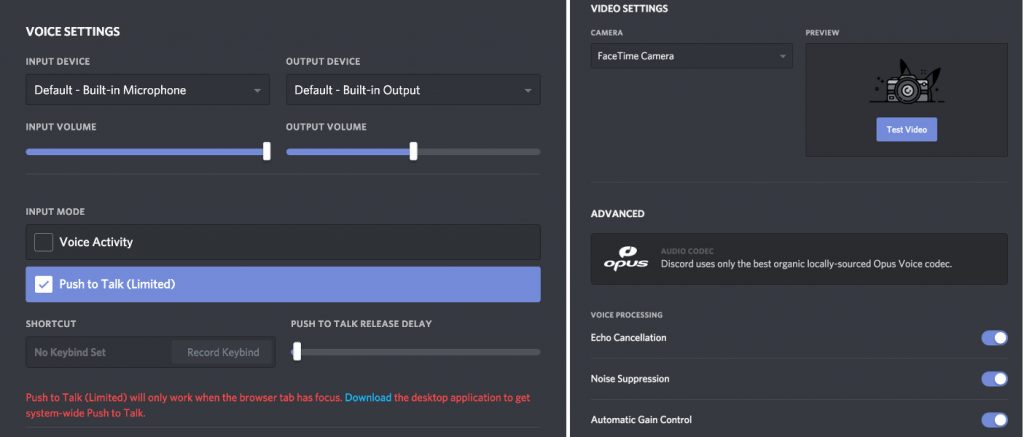
You'll need to figure out which of these is the microphone for which you want to apply the echo cancellation. Notice that in my example, 2 of the sources have "input" in their names.
PARSEC DISCORD ECHO CANCELLATION NOT WORKING HOW TO
How to choose the microphone in setups with multiple microphones, to use with the PulseAudio module-echo-cancel In case you want to unload the echo cancel PulseAudio module you can run: When you click on it, it should load the echo / noise cancelling PulseAudio volume.Īfter you run this, look in your system's sound settings and the input and output devices should both have the default name, but with "echo cancelled with." in parentheses, like in the screenshot at the top of the article. You should now see a new entry called Echo Cancel PulseAudio Module in your applications menu. do this from the command line using:Ĭp sktop ~/.local/share/applications/ Save the file and copy it to ~/.local/share/applications/, e.g. Create a file called sktop in your home folder with the following contents: Ĭomment=Load the PulseAudio module-echo-cancelĤ. You can make it executable and place it in /usr/local/bin using this command:ģ. After saving the file, make it executable and copy it somewhere in your path. This unloads module-echo-cancel if it was already loaded, then loads this module with webrtc as the echo cancellation method (it should be better than the default speex), specify a source and sink names, then set that source and sink as default.Ģ. Pactl load-module module-echo-cancel aec_method=webrtc source_name=echocancel sink_name=echocancel1 Create a new file in your home folder called echocancel with the following contents: #!/usr/bin/env bash To have echo / noise cancellation of the microphone input only when you need it (by having an application menu entry to turn this on), follow the steps below.ġ. How to enable the PulseAudio module-echo-cancel on demand If this doesn't work for you, see the second method below, for how to load module-echo-cancel on demand. "Built-in Audio Analog Stereo (echo cancelled with Built-in Audio Analog Stereo)" like in the screenshot at the top of the article. After saving the file, reload PulseAudio using this command:Īfter this, look in your system's sound settings and the input and output devices should both have the default name, but with "echo cancelled with." in parentheses, e.g. This is what this does: if your system PulseAudio is compiled with the echo / noise cancellation module, load this module, use webrtc as the echo cancellation method (it should be better than the default speex), specify a source and sink names, then set that source and sink as default.Ģ. Load-module module-echo-cancel aec_method=webrtc source_name=echocancel sink_name=echocancel1 Scroll down to the end of this file and paste the following. Edit /etc/pulse/default.pa as root with a text editor, like Nano (command line text editor) for example: To always have echo / noise cancellation on your Linux desktop using PulseAudio, having module-echo-cancel loaded at startup, follow the steps below.ġ.


How to enable the PulseAudio module-echo-cancel on startup ] For those that have multiple microphones attached to the computer, I've added a new section to this article which explains how to choose for which microphone to apply the echo / noise cancellation (the new section is called How to choose the microphone in setups with multiple microphones, to use with the PulseAudio module-echo-cancel). Also, in my case, having module-echo-cancel load at startup does not work at all (I'm not sure why), but it can be loaded after logging in with no issues, using the second method below. This is not just to offer 2 alternatives, but also to work around a PulseAudio bug that happens for example when plugging in a headset after loading the Echo Cancel module, which causes this not to switch automatically to the new sink_master. I'll show you 2 ways of enabling the PulseAudio Echo Cancel module: one that makes it permanent so it's automatically started when you login to your desktop, and another one that allows you to enable echo cancellation on demand, when you need it. This module is not enabled by default on most (if not all) Linux distributions, so this article will show you how to enable it. PulseAudio comes with a module that can be used to perform acoustic echo cancellation of the microphone input, and some background noise reduction.


 0 kommentar(er)
0 kommentar(er)
